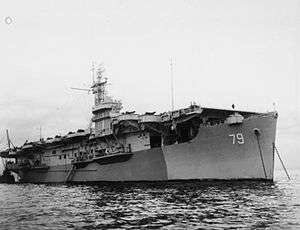Ruler-class escort carrier
 HMS Puncher | |
| Class overview | |
|---|---|
| Name: | Ruler class |
| Builders: | Seattle-Tacoma Shipbuilding Corporation |
| Operators: |
|
| Preceded by: | Attacker class |
| Succeeded by: | None |
| Built: | 1942–1943 |
| Planned: | 25 |
| Completed: | 25 |
| Lost: | 2 |
| General characteristics | |
| Type: | Escort carrier |
| Displacement: | 11,420 long tons (11,600 t) |
| Length: | 492 ft 3 in (150.0 m) |
| Beam: | 69 ft 6 in (21.2 m) |
| Draught: | 25 ft 6 in (7.77 m) |
| Installed power: | 9,350 shp (6,970 kW) |
| Propulsion: | 1 shaft geared steam turbines |
| Speed: | 17 kn (20 mph; 31 km/h) |
| Complement: | 646 |
| Armament: |
|
| Aircraft carried: | 24 |
| Aviation facilities: |
|
| Notes: | Built in two groups of 11 and 15 |
The Ruler class of escort aircraft carriers served with the Royal Navy during the Second World War. All twenty-five ships were built by the Seattle-Tacoma Shipbuilding Corporation in the United States as Bogue-class escort carriers, supplied under Lend-Lease to the United Kingdom.[1] They were the most numerous single class of aircraft carriers in service with the Royal Navy.[2]
As built they were intended for three types of operations, "Assault" or strike, convoy escort, or aircraft ferry.[3]
Design and description
These ships were all larger and had greater aircraft capacity than all preceding American built escort carriers. They were laid down as escort carriers and were not converted merchant ships.[4] All the ships had a complement of 646 men and an overall length of 492 feet 3 inches (150.0 m), a beam of 69 feet 6 inches (21.2 m) and a draught of 25 ft 6 in (7.8 m).[4] Propulsion was provided by one shaft, two boilers and a steam turbine giving 9,350 shaft horsepower (SHP), which could propel the ship at 16.5 knots (30.6 km/h; 19.0 mph).[5]
Aircraft facilities were a small combined bridge–flight control on the starboard side, two aircraft lifts 43 feet (13.1 m) by 34 feet (10.4 m), one aircraft catapult and nine arrestor wires.[4] Aircraft could be housed in the 260 feet (79.2 m) by 62 feet (18.9 m) hangar below the flight deck.[4] Armament comprised: two 4 inch Dual Purpose guns in single mounts, sixteen 40 mm Bofors anti-aircraft guns in twin mounts and twenty 20 mm Oerlikon anti-aircraft cannons in single mounts.[4] They had a maximum aircraft capacity of twenty-four aircraft which could be a mixture of Grumman Martlet, Vought F4U Corsair or Hawker Sea Hurricane fighter aircraft and Fairey Swordfish torpedo bomber or Grumman Avenger anti-submarine aircraft.[4]
Ships
First group
- HMS Patroller
- HMS Puncher
- HMS Ravager
- HMS Reaper
- HMS Searcher
- HMS Slinger
- HMS Smiter X
- HMS Speaker XX
- HMS Trouncer
- HMS Trumpeter X
Second group
- HMS Arbiter
- HMS Ameer XX
- HMS Atheling X
- HMS Begum X
- HMS Emperor XX
- HMS Empress
- HMS Khedive X
- HMS Nabob X (torpedoed 22 August 1944, by U-354 (O/L Hans-Juergen Sthamer) west of the North Cape)[6][7]
- HMS Premier X
- HMS Queen X
- HMS Rajah
- HMS Ranee
- HMS Ruler XX
- HMS Shah X
- HMS Thane (torpedoed 15 January 1945, by U-1172 (O/L Juergen Kuhlmann) in the Clyde estuary).[6][8]
- X = Fitted for anti-submarine warfare.[4]
- XX = Fitted for strike-operations.[4]
- All the others were mainly used for aircraft transport with an added strike capability.[4]
Notes
- ↑ Cocker (2008), p.81
- ↑ Cocker (2008), 74–84
- ↑ Gordon Smith (ed.), "US-built escort aircraft carriers", Lt Cmdr G Mason - His Service Histories of Royal Navy Warships in World War 2 and Other Researches, naval-history.net
- 1 2 3 4 5 6 7 8 9 Cocker (2008), p.82.
- ↑ Cocker (2008), p.79.
- 1 2 Cocker (2008), p.83.
- ↑ http://www.uboat.net/allies/merchants/ships/3330.html
- ↑ http://www.uboat.net/allies/merchants/ships/3425.html
- Bibliography
- Cocker, Maurice (2008). Aircraft-Carrying Ships of the Royal Navy. Stroud, Gloucestershire: The History Press. ISBN 978-0-7524-4633-2.
Commonscat
| Wikimedia Commons has media related to Ameer class aircraft carrier. |